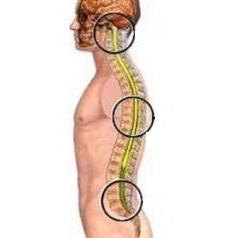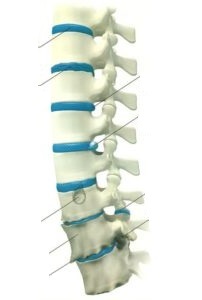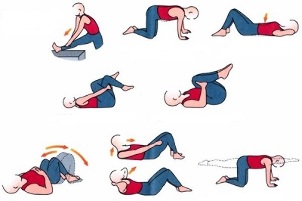Osteochondrosis of the lumbar spine is observed among the pathological processes of axial skeletal tissue, whose symptoms and treatment have their own characteristics. The frequency of diagnosing the disease does not decrease over time. What is lumbar spine osteochondrosis? This is a special type of degenerative-dystrophic change in axial intervertebral disc tissue with subsequent damage to joints and ligaments. The photo shows the appearance of the affected vertebra.
Osteochondrosis of the lumbar spine, what is it?

The lumbar region of the axial skeleton experiences maximum pressure. As a result, the high frequency of diagnosing osteochondrosis in this area of the spine is inadvertent.
The cause of lumbar osteochondrosis has long been identified and well studied. The disease can manifest itself in patients from the age of 30 years. But the older generation and representatives from the stronger half of the world community tend to face pathology.
Timely treatment of lumbar spine osteochondrosis provides an opportunity to avoid decreased work capacity, quality of life, and disability.
Sick patients are strictly forbidden to experience hypothermia and vigorous physical activity. Weightlifting, speeding, jogging, jumping, horse riding, aerobics, motor sports are contraindications for osteochondrosis.
Causes of disease
A number of external and internal factors cause the manifestation of symptoms of degenerative-dystrophic changes in axial skeletal intervertebral disc tissue. Symptoms of lumbar spine osteochondrosis, including dorsalgia of the back, cause discomfort, discomfort, and stiffness of movement.
Among the causes of pathological development, it should be noted:
- increased load on the lumbar spine due to certain conditions for performing work tasks, repair work, lifting weights during training by professional and amateur athletes;
- implementation of sharp and complex movements;
- overweight, which determines the symptoms of lumbar pathology in women and men;
- hypothermia;
- incorrect posture, causing uneven load distribution on the axial skeleton;
- inactive lifestyle, which has a negative effect on elasticity, blood supply to each vertebra;
- lack of ability to sit and move properly;
- congenital back pathology or back injury due to playing sports, falling from heights, traffic accidents;
- lack of a balanced diet enriched with vitamins, minerals, micro elements, as well as proper diet, exercise, rest regimen regulation;
- normal stress conditions;
- hormonal disorders in the female body during pregnancy and menopause;
- violation of metabolic processes in the patient's body;
- genetic predisposition, which determines the loose porous structure of spinal tissue and accelerates their degenerative-dystrophic changes;
- addiction to alcoholic beverages, smoking tobacco products, which accelerates the aging process in the human body.
Flat feet, wearing uncomfortable shoes, vitamin deficiency, poor environmental conditions are also causes of lumbar spine osteochondrosis. Exclusion of a number of factors will help prevent the development of pathology. When confirming the diagnosis of lumbar osteochondrosis, it is recommended to treat it immediately, without waiting for complications. Ignoring the advice of a qualified specialist leads to manifestations of dorsalgia and other complications. Vertebrologists know how to cure lumbar axial skeletal osteochondrosis and quickly provide first aid for severe pain.
Symptoms of Disease

The lower spine is an important part of the spine. And the timely diagnosis of lumbar osteochondrosis, the treatment recommended to begin as early as possible, eliminates the risk of unpleasant consequences. Degenerative-dystrophic diseases of the axial skeleton have specific symptoms.
Signs of osteochondrosis of the lumbar spine are included in the special list. The most common are:
- inability to perform back bends, torso rotation;
- decreased flexibility, lumbar spine movement, which can be treated at home, according to the doctor's recommendation;
- depression;
- increased fatigue, irritability, restlessness, manifesting in lumbar spine osteochondrosis, its symptoms and treatment have their own characteristics;
- dorsalgia in the lumbar region, which causes problems when urinating, defecating, performing daily hygiene procedures;
- the appearance of problems during night breaks;
- increased sweating;
- appearance of tingling and cold sensation in the lower part of the foot.
Signs of lumbar osteochondrosis like this indicate the need to seek the help of a qualified specialist. Vertebrologists will always help cure these diseases, to make patients' lives better, relieving them of dorsalgia, discomfort, stiffness, and discomfort.
Complications of the disease
Long-term degenerative-dystrophic changes in the axial skeletal intervertebral disc tissue without proper treatment lead to the development of complications and pathology of the patient's internal organs. Timely diagnosis of lumbar spine osteochondrosis, a symptom that indicates the need to seek the help of a vertebrologist, eliminates the risk of its occurrence. Ignoring the advice of the attending physician leads to new problems with health, well-being and quality of life.
Complications of osteochondrosis of the lumbar spine, treatment should be done after confirmation of the diagnosis, without waiting for dorsalgia, including:
- violations of the menstrual cycle in women and sexual activity in men;
- varicose veins and leg artery spasms;
- dysfunction of the genitourinary system;
- sciatic nerve irritation and neuralgia;
- pain that manifests itself in the kidney area and resembles dorsalgia in the lumbar spine;
- protrusion and hernial protrusion of the intervertebral disc and the spine itself;
- radiculitis, acute and chronic lumbodynia, disability.
Unpleasant consequences of lower back osteochondrosis, if not properly treated, cause mental disorders, depressive conditions and deterioration of quality of life not only the patient himself, but also those around him, relatives, close people. They also have information on how to determine osteochondrosis.
Stages of this disease
Vertebrologists, when asked if it is possible to cure lumbar spine osteochondrosis, give a positive answer provided they get timely medical help. They distinguish four stages of disease development, each manifesting itself at a particular time and having its own distinct characteristics. This includes:
- The first stagepathology, distinguished by the sensation of mild pain, exacerbated by physical exercise, discomfort in the lumbar region, onset of destruction of the intervertebral disc;
- Stage 2of the disease, characterized by a decrease in distance between the vertebrae due to pathological changes in the fibrous ring, pinched nerve processes, the appearance of severe pain in lumbar osteochondrosis;
- Stage 3of the disease, its characteristic features include the destruction of severe fibrous rings, the formation of hernial protrusions, significant deformity of the axial skeleton;
- The fourth stageof the disease, is characterized by serious problems with the motor ability of patients who have to treat lower back osteochondrosis at home or in the hospital wall, as well as the risk of becoming disabled.
Pathological diagnostics
Patients are advised to know which doctor treats spinal osteochondrosis and how to treat lumbar osteochondrosis at home. The vertebrologist, after collecting the anamnesis, external examination of the sick person, prescribes diagnostic measures. Their list includes:
- blood tests, clinical biochemistry;
- X-ray, which provides an opportunity to obtain information on the condition of the axial skeleton and prescribe proper treatment of lumbar osteochondrosis at home or in hospital;
- computed tomography, characterized by a lower radiation load on the body, allows for a more in-depth examination of the axial skeletal pathological zone and answers the question of whether osteochondrosis can be treated at this stage of development;
- magnetic resonance imaging, based on the use of electromagnetic radiation, as well as providing a painless and harmless examination of the lumbar spine osteochondrosis.
Modern diagnostic methods are among the most informative research methods. The results form the basis for confirming the diagnosis of lumbar spine osteochondrosis, symptoms that indicate the presence of back problems, and also provide an opportunity to prescribe appropriate treatment for axial skeletal pathology.
How to deal with osteochondrosis and how to get rid of its symptoms
Vertebrologists who know how to treat lumbar axial skeletal osteochondrosis at home will always help sick patients. After receiving the results of pathological zone examination of the spinal space, a number of measures are prescribed to relieve the symptoms of the disease and prevent the development of complications. The treatment regimen for lumbar spine osteochondrosis is developed taking into account the age category of the patient, characteristic of axial skeletal structure. Allergies are also determined, which can manifest themselves against the background of medication intake.
Key steps aimed at treating osteochondrosis effectively include:

- drug therapy based on the intake of non-steroidal anti-inflammatory drugs, hodroprotectors, muscle relaxers, vitamin complexes, phytopreparation;
- performs restrictions that relieve severe pain in lumbar osteochondrosis, the symptoms, of which the treatment has its own characteristics;
- water treatment and axial stretching, which are recommended to be done periodically;
- medical massage;
- Exercise therapy, which is prescribed to strengthen skeletal muscle, makes the spine more flexible and does not raise the question of how to cure lumbar osteochondrosis;
- using traditional medicine recipes.
Treatment of osteochondrosis of the lower back is done with a background of diet and a balanced diet. Rejection of bad habits is also a necessary step to prevent the development of the disease. Prevention of orthopedic osteochondrosis of the lumbar spine provides an opportunity to avoid surgery.





































